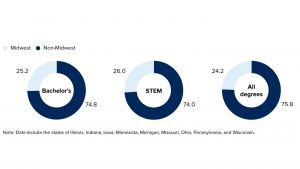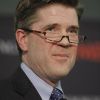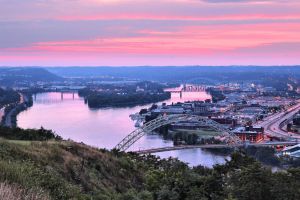The Midwest possesses a dynamic political and economic history that lies at the center of America’s economic growth and keeps the region front and center in politics today.
Key Findings
The Midwest has a unique economic, social, and cultural history and development storyline.
The region stretching from Minnesota, Iowa, and Missouri in the west along the Great Lakes and Ohio River Valleys to Pennsylvania and New York in the east includes all or part of 12 states that built a highly interconnected agro-industrial economy over generations (Figure A). This region, home to more than 70 million people, possesses a dynamic political and economic history that lies at the center of America’s economic growth and keeps the region front and center in politics today.
A lot has changed since the Midwest served as the birthing ground of the great industries—processed food, retail commerce, aviation, cars, chemicals, steel, electronics, machinery, consumer durables, and many more—that powered 20th-century America.
Much has also changed since a generation ago, when globalization and new industrial rivals diminished the region’s economic primacy, shuttered hometown employers’ doors, and left many communities struggling. This collective transition earned the region its “Rust Belt” moniker.
Over recent years, the forces of technological disruption, new lifestyle and work preferences of young and mobile talent, changing demographics, and media in an increasingly wired world have continued to alter the dynamics of the global marketplace, the shape of communities, and the economic position and possibilities for the residents of the region.
Today the Midwest is neither an economic monolith nor, despite lingering popular misconceptions, a “Rust Belt.” Many Midwest communities, large and small, have successfully evolved from their industrial and farming roots and are winning in today’s globalized, tech-based, and knowledge-driven economy. Most of the region’s major metros—from the Twin Cities in the west to Indianapolis at the nation’s crossroads to Pittsburgh in the east—are diverse, thriving hothouses of knowledge work.
Figure A: The Midwest

Source: Chicago Council on Global Affairs
What’s more, all of the communities anchored by one of the region’s numerous top-flight research universities (such as Iowa City, Ann Arbor, and State College) are thriving in an economic era in which talent and innovation dominate.
Many other Midwest communities that are neither major metros nor home to top research universities have also found paths to new success by embracing the forces of economic change and building on their particular assets to create a new era of economic vitality.
These include cities such as Columbus, Indiana; Midland, Michigan; and Rochester, Minnesota—cities that are thriving as their anchor employers stay on the cutting edge of innovation in emerging sectors. Others—such as Rockford, Illinois, and Troy, Michigan—succeed by engaging economically and socially with the world, selling to global markets, and welcoming immigrant talent and new populations. Grand Rapids, Michigan, and Milwaukee are growing their economies and reinvigorating their communities through leadership in the “green” and “blue” economies of tomorrow, building a foundation in environmental sustainability and smart-water technologies. Kalamazoo, Michigan, and Georgetown, Kentucky, succeed by marking themselves as either highly educated communities or places that have workers equipped with the skills needed to compete in a changed economy.
Others, such as Eau Claire, Wisconsin, and Brown County, Indiana, harness particular local assets of natural location, historical and cultural attributes, and a special quality of life. Still others, such as Minneapolis-Saint Paul, having turned the economic corner, are accelerating growth by forging more inclusive communities and shared prosperity.
Additional efforts can be made to support communities that are making strides but have yet to fully turn the corner. In this report, we suggest a new designation for such cities and towns: “Communities in Transition.” Purposeful and strategic efforts on the part of Midwest public- and private-sector leaders, coupled with a federal designation that allows for increased financial assistance, can help support these and other communities to thrive in the new economy as the old one fades from view. And when Midwest communities do find economic purchase in this new era, their residents are often more optimistic, forward-looking, less responsive to nativism and nostalgia, and less inclined to retreat from the world.
Accelerating economic change across the Midwest
Today there are two Midwests. While many communities have successfully outgrown their industrial shells and boast diversified and dynamic economies, the region is also home to the country’s largest number of older industrial communities that, having lost anchor employers, remain adrift.
The region’s uneven success in adapting to economic change and residents’ anxieties about the future put the Midwest on the map in 2016, when key Midwestern states played a determinative role in the US presidential election.
As we enter 2020 and attention remains focused on the people and places of the Midwest, the region’s leadership, as well as national leaders looking to nurture new economic opportunity for Americans in many left-behind places, must articulate and make real an affirmative, outward-oriented economic vision for the future of the region—an agenda for action that reaches citizens and communities across the Midwest, building on the region’s many economic strengths, addressing its particular challenges, and helping residents adapt successfully to today’s disruptive forces of automation, global interdependence, and demographic change.
The good news is that the region has powerful assets that matter enormously in the economy of today. Home to globally engaged companies and producers, the Midwest remains a huge domestic market with an unrivaled network of top universities and colleges that, per capita, produce a larger share of US talent and innovations.
As climate change takes an increasing toll on other regions, the Midwest’s natural assets provide a haven and sustainable platform for population and economic growth. Home to rich farmland and 20 percent of the world’s surface freshwater in the Great Lakes, the Midwest boasts other valuable natural amenities as well. These include 10,000 miles of freshwater coastline along the Great Lakes, thousands of inland lakes, countless rivers and forests, and many scenic and recreational areas. The Midwest is also home to communities with a rich quality of life and iconic architecture, arts, culture, and history—communities that are warmed by Midwestern traditions and values and provide a cost-of-living 20 percent lower than elsewhere in the country.
But to succeed uniformly, the region must also confront head-on the unique challenges presented by an economy and society built during the region’s 20th-century heyday: a dearth of capital to turn the region’s innovation into new jobs and businesses; many workers with only a basic high school education in a workplace defined by rising skill demands; and an economic security system of pensions, healthcare, and unemployment adjustment built for the industrial era that doesn’t support the region’s workers today.
Figure B: Midwest shares of US higher-education degrees
2016 - 2017 academic year, %

Source: National Center for Education Statistics, US Census Bureau
Vital Midwest
The Midwest has some of the country’s oldest infrastructure, and the costliest to repair, with an outsize share of brownfields and polluted areas. The region is defined by a fractured political landscape and the most racially segregated communities in the country. And the existence of thousands of local government units, many with a dwindling tax base, means that communities have limited ability to organize to meet the needs of their own residents, not to mention compete with other global regions.
Figure C: Expensive Midwest infrastructure needs
Infrastructure costs per capita, $

Source: 2017 Infrastructure Report Card, American Society of Civil Engineering, 2017
Despite these challenges, the success of so many people, places, and businesses, firmly anchored in the Midwest and succeeding in today’s global economy, demonstrates that there is a positive and achievable vision for a newly Vital Midwest—a Midwest that:
Thrives in a globalized economy and adapts to dramatic technological, demographic, occupational, and environmental change, while accelerating business growth and innovation in emerging sectors
Engages globally and is connected to the world, serving as a leader in international trade while building on its talent base and attracting new and diverse populations
Harnesses unique place-based assets ranging from abundant woods and waters to special histories, culture, and values that help people and places find economic purchase in a changed economy
Provides a new image of the Midwest as the center of innovation and growth in emerging jobs and industries, and as a magnet for talent enabled by attractive and globally engaged places to live, work, play, and operate businesses
It is no overstatement to say that in 2020 the eyes of the country, and much of the world, are focused on the economic position, attitudes, and disposition of Midwesterners, given their defining role in the 2016 election and the pivotal position of key swing states in 2020.
An urgent national and Midwestern priority is to foster more inclusive and broadly shared economic opportunity so that fewer people and communities feel abandoned, isolated, and unable to control their economic destiny. Leaders within the region and those seeking the presidency—who will likely require the support of Midwestern voters—must provide alternative visions to isolationism, protectionism, and nostalgia as fixes for residents’ economic woes.
The blueprint for spreading economic opportunity and optimism to more people in the region is to model existing community paths to success; implement effective programs, policies, and public–private partnerships; and advance reinforcing federal priorities.
In particular, the blueprint will rely on state and local partnerships and federal policies that support:
- Emerging-sector innovation hubs: Organize state and local public–private partnerships and increase federal investment in research, development, and innovation in the emerging sectors of energy, water, food systems, mobility, healthcare, and information technology (IT) focused through innovation institutes, housed at Midwestern research universities.
- Capital for “Communities in Transition”: Create additional state, local, and public–private innovation funds. And, as part of a new federal place-focused economic development agenda, create new investment funds to provide favorable tax treatment of private-sector investments in regions and communities with transitioning economies.
- Open doors and fair trade: Build state and local leader advocacy and organizations to support domestic exporters, explore foreign markets, and advocate for federal trade policy that creates a stable, predictable environment; opens markets; and secures opportunities for exports while ensuring a steady supply of fairly traded imports.
- Green leadership: Set goals for sustainability and provide leadership. Mayors, governors, and the US president can set a goal of 90 percent clean energy by 2050, and the federal government can recommit to global agreements to reduce carbon emissions and greenhouse gases. Such commitment will drive Midwest-based clean energy innovation, new technology development, and business and job growth.
- “GI Bill for Workers”: Support state policy leadership and federal flexibility allowing states to package dollars to deliver a financial guarantee for postsecondary credentialing for the existing workforce, with those most at risk of dislocation concentrated in the Midwest.
- Portable pensions and healthcare: Support federal policies that create incentives for states to develop public–private portable pension, savings, and healthcare programs to maintain worker security and support mobility in a changing labor market.
- Community-based free college: Catalyze community-based higher education “promise” programs similar to the Kalamazoo Promise through a new federal-state-local investment matching program.
- Infrastructure policy and funding that significantly increases federal subsidies: Provide additional federal resources for infrastructure modernization, with financing flexibility to support multimodal infrastructure priorities at the state and local levels.
- Economic development focused on “Communities in Transition”: Package existing federal economic and business development and support services, focusing them on newly defined transitioning economies. Incorporate criteria to support policies that reward collaborative, community-driven, inclusive growth strategies.
- Heartland Visas for “Communities in Transition”: Support immigration policies that provide greater access to newly designated Communities in Transition for high-skill immigrants, refugees, entrepreneurs, and guest workers, and that support paths to citizenship for DREAMers—young, undocumented immigrants who came to the United States as children.
There was a time when the nation and Midwestern leaders joined together to develop land, higher education institutions, and an economic infrastructure that supported one of the strongest economies on earth and put the region, and the country, at the front of the world stage. In the early part of the 20th century, the forward economic march of the Midwest faced a wave of isolationism and nativism driven by the First World War and the seismic economic dislocations of the Great Depression. But rather than succumb to these trends, the region’s business, labor, civic, and political leaders crafted an affirmative and engaged economic and social response to a changing world. That time has come again. A new 21st-century vision and partnership to build a Vital Midwest will help reinvigorate our nation’s economy by extending opportunity to people and places that have been left out of today’s economic transformation, and go a long way toward healing our nation’s political divides as well.




